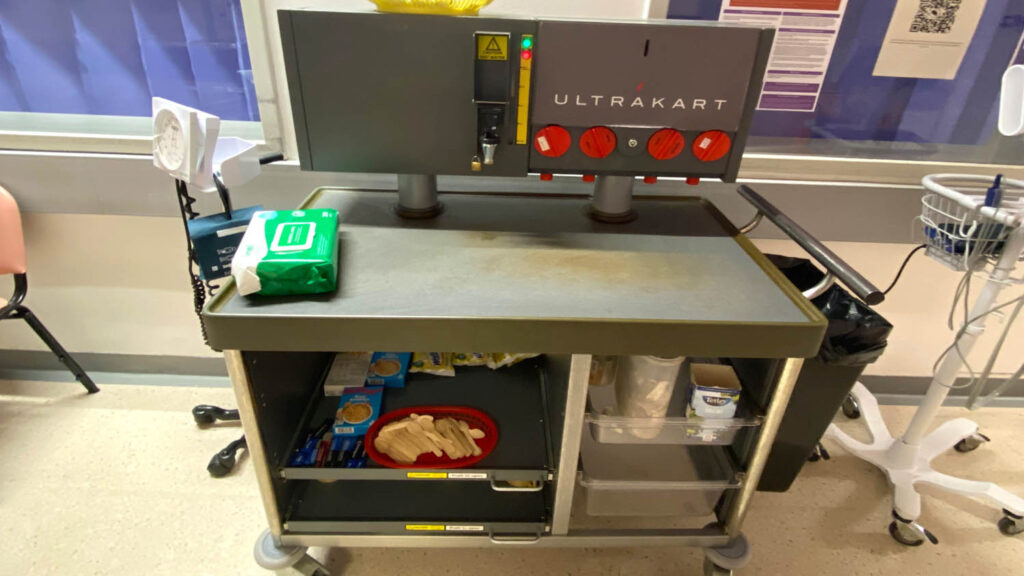The recent arrival of his baby son brought Stephen Holmes into contact with a pretty mundane piece of hospital equipment. It’s got him thinking about the comfort of familiar objects during challenging times
The arrival of my first-born was not the moment I had down as inspiring an ode to a hospital hot drinks cart, but here we are.
Most of my December days were spent as a visitor to our local maternity ward, while my wife received postnatal treatment following the birth of our son. Book-ended by winter darkness, the days indoors were long ones. The two patients, both of whom slept for the majority of the time, left me with long stints of time alone, spent reading or exploring the ward’s corridors.
Not that there was much to find. The festive period meant that the usual flurry of activity was reduced. The cafes and canteens had shut their doors. On Christmas Eve, the limited number of vending machines were all pillaged by the arriving night shift. They weren’t restocked until well after Boxing Day, which is where my dependence on the hot drinks trolley became a ritual that provided both sustenance and markers of the time that had passed.
The trolley’s grey sheet metal and red industrial twist shut-off knobs (used to deposit shots of instant coffee or sugar) gave it an air of Bauhaus. The name of the ‘Ultrakart’ and the font used to display this name were both equally Germanic.
I visited the Ultrakart multiple times, day and night. It was a bastion of functionality, parked in a corridor, where weary birth partners would congregate. Some were still adrenaline-fuelled by the appearance of their child moments earlier; others were ashen-faced, having spent days maintaining a positive demeanour in front of their child’s mother. Stepping out into the corridor to pour hot drinks into small, beige plastic cups gave us all a moment to ourselves, a brief period of reflection in which to process what was going on.
Comforting familiarity
In my working life, I spend a lot of time listening to designers talking about cutting-edge technologies, about shaping the future with digitally enhanced products and explaining the lengths to expertly hone a product’s functionality based on their observations of user behaviour. As is to be expected, the hospital was awash with such equipment – monitors, beds, instruments and more.
Standing at the Ultrakart gave us all a moment to ourselves, a brief period of reflection
Nearly everything there beeped and bleeped. Nearly everything had been built via this process: watched in its function as part of a workflow, buttons exactly judged, mouldings and materials thoughtfully considered. Everything about these objects had been impeccably thought-through by their designers.
During those long hours, I wondered how much user-centred research, intrinsic ergonomic analysis and iterative prototyping had gone into making my new favourite trolley. Given that it was made of bent sheet metal and pre-existing parts bolted onto a wheelie cart with a water heater slapped on top, I quickly concluded it was not a huge amount.
Apart from the caffeine, that’s what grabbed my attention. It offered simplicity in a world governed by medical professionals and procedures. It made you feel not entirely useless at a point when you were not in control of the situation.
Sometimes reassurance is what’s needed in a taxing situation, one in which you find yourself a very long way out of your comfort zone. Sometimes, this can be found in a physical product.
I think most of us have an example in our lives: an object that maybe isn’t the most advanced of its type, that we’ve held on to well past its best days, or that isn’t even the best tool for the job, but which we plug on with anyway, because as humans, we’re capable of tying emotions to those inanimate objects. Typically, the more analogue, the better.
The hospital drinks trolley couldn’t conjure up a fancy double espresso with a big glug of bourbon, which certainly would have been welcome on more than one occasion. But I was so enamoured with it at the time that I took a photo of it on my phone, where it’s saved on my handset among the first images of my son.
Now that the delirium has passed, the pure and basic functionality of its design still stands out in my mind, even among all the literally lifesaving technologies we came into contact with during those days.
So, if you are in any small part responsible for the design of the Ultrakart, then you have my thanks. I raise a small plastic mug of tea to you.






